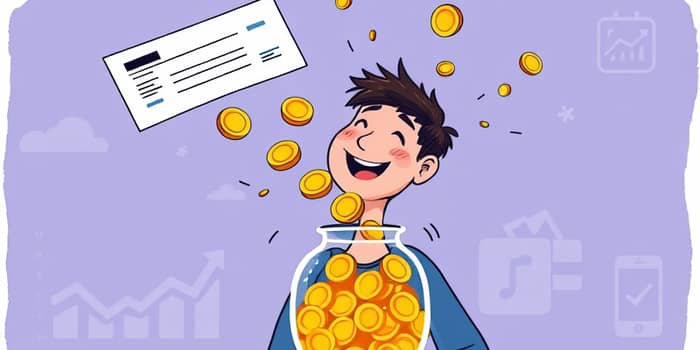
You have worked hard to earn every paycheck, but are you securing your future before spending? The strategy known as “pay yourself first” flips traditional budgeting by placing savings at the top of your financial to-do list. When combined with automated bank transfers or fintech apps, it becomes a powerful habit that builds wealth without requiring constant willpower.
In this article, we explore the core principles, practical steps, and real-life numbers behind automatic transfers. You will discover how small, consistent contributions can grow into a robust financial safety net and help you achieve both short-term and long-term goals.
At its heart, paying yourself first is about prioritization. Instead of saving what remains after expenses, you save before anything else. This simple inversion creates a mindset shift that transforms your relationship with money.
Psychologists refer to this approach as behavioral automation. By removing the decision-making process each time your paycheck arrives, you circumvent common pitfalls like decision fatigue and emotional spending. With automation in place, saving no longer competes with other financial demands.
Adopting this strategy also forces financial discipline. Because funds leave your checking account immediately, you learn to adjust your spending habits to the income you have left. Over time, you internalize a lean but sustainable budget that supports both daily needs and future aspirations.
Automating your transfers turns a good intention into a daily reality. Once you set up a schedule, the process is virtually maintenance-free, letting you focus on other aspects of your life.
These benefits combine to form a virtuous cycle. As your savings balance grows, emotional stress often decreases, reinforcing the habit and making you more likely to maintain discipline during challenging times.
In fact, behavioral finance studies emphasize that automating transfers leverages the same psychological triggers that advertisers and subscription services exploit, except in this case the outcome is positive growth of your own resources rather than impulse purchases. This harnesses powerful automatic behaviors in your favor, effectively making savings a default option.
Consider someone who earns $4,000 per month. By directing 10 percent ($400) into savings through automatic transfers, that individual lives on the remaining $3,600. Over a year, this approach accumulates $4,800 without requiring any active decisions beyond the initial setup.
Statistics from multiple studies reveal that automated savers are up to 3.5 times more likely to reach financial goals compared to those relying on manual or sporadic transfers. This performance difference stems largely from consistency and the magic of compounding interest.
For example, if your savings account yields a modest 2 percent annual interest, the $400 monthly contributions will not only add $4,800 per year but will also earn additional interest. That interest itself will earn interest, creating exponential growth over decades.
Freelancers and gig workers with erratic income can benefit by using a fixed percentage of each payment. Instead of a fixed dollar amount, allocate a percentage of every invoice to savings, ensuring that when you earn more, you save more without manual recalculation.
Getting started is straightforward. You can often arrange transfers through your existing bank’s online portal or a dedicated savings app. Follow these steps to ensure a smooth implementation.
As your income grows, revisit the transfer amount. Incremental increases over time ensure that your savings rate keeps pace with your earning power without creating sudden budget shocks.
While automatic transfers are powerful, certain pitfalls can undermine success. One common mistake is setting unsustainable amounts. If a transfer risks causing overdrafts, then adjust to a lower level until you have more breathing room.
An additional challenge arises when you neglect to update or cancel transfers after significant life changes, such as a new job, a major purchase, or unexpected expenses. Periodic reviews—perhaps quarterly—help keep your automation aligned with your evolving goals.
Another key tip is to set specific objectives. Vague goals like “save more” lack the motivational force of clear targets such as building a six-month emergency fund or saving for a down payment. Goal specificity increases accountability and satisfaction as you see progress over time.
To avoid unexpected shortfalls, keep a small buffer of at least one week’s expenses in your checking account before transfers hit. This prevents unwanted overdrafts and fees and maintains peace of mind during leaner weeks.
Beyond basic transfers, you can leverage advanced features to fine-tune your approach. Many fintech apps offer round-up programs that convert spare change into savings automatically after each purchase. Others provide goal trackers, visual dashboards, and tailored nudges to keep you motivated.
If you want to diversify, consider channeling transfers into different accounts depending on your objectives. For instance, a high-yield savings account might hold your emergency fund, while a certificate of deposit (CD) could serve longer-term ambitions with higher rates for a set term.
Pair automatic transfers with a budgeting framework such as the 50/30/20 rule—reserving 20 percent for savings—and automate that segment. This approach integrates effortlessly with existing guidelines and relieves the mental burden of allocating funds on your own.
Regular progress tracking not only shows you how close you are to your targets but also provides psychological rewards that reinforce saving behavior. Celebrating milestones—no matter how small—can turn what once felt like a chore into a fulfilling journey.
Paying yourself first with automatic transfers is a simple yet transformative strategy. By prioritizing savings before spending, you build a foundation of financial security with minimal effort. Over time, the combination of disciplined transfers and compound interest turns modest contributions into significant wealth.
Imagine the relief of watching your emergency fund steadily climb, knowing that the day you need financial support, it will be there. Picture the thrill of hitting your vacation goal or down payment target without the stress of manual saving. These outcomes are within reach when you decide to pay yourself first.
Embrace automation today, and let your future self thank you. As you witness your savings grow, you will gain confidence, resilience, and the freedom to pursue your most ambitious dreams without being held back by financial uncertainty.
References













